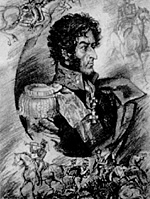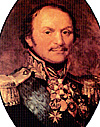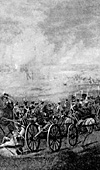Peter Bagration:
The Best Georgian General
of the Napoleonic Wars
Part 2: Change of Plans
By Alexander Mikaberidze,
Chairman of the Napoleonic Society of Georgia
| |
A Change of PlansGeneral Bagration also provided to the Minister what he saw was the most likely French courses of actions. It was his opinion, the enemy would attack and route individual corps of the Russian before they could concentrate. "It is to his benefit to divide our forces, and he, in my opinion, will try to take advantage of it" - informed Bagration. On 13 June, Bagration received instructions from Barclay de Tolly, dated 12 June. These orders changed the mission of the 2nd Western Army. The orders stated, that in connection with the massing of the enemy forces between Kovno and Meretsh and a crossing of the Niemen River, expected on 12 June, the Platov's Cossacks Corps was ordered to operate in the area of Grodno on the flank and rear of the enemy. The 2nd Western Army should assist the Cossacks by protecting their rear. At the same time Borysov was specified as a point where the 2nd Western Army should move to if forced to retreat. Further instructions informed Bagration, that if the 1st Western Army could not force a battle at Vilna, it would be concentrated at Swentsyan where they would fight. On 14 June, General Bagration received one more instruction from the Military Minister, informing him that the French Army had crossed the Niemen at Kovno and his intention to concentrate the 1st Western Army at Vilna. Barclay de Tolly confirmed the mission of the 2nd Western Army as stated in their orders of 12 June. The new instructions of Barclay de Tolly did not ease the situation of the 2nd Western Army. In fact, it considerably complicated it. He was ordered to act on the flank and rear of the enemy, but he was not given any information on the enemy's route of march or the direction he was supposed to move. Furthermore, there was nothing in the instructions about the purpose behind the proposed movements. Additionally these instructions did not take into account the enemy forces that were concentrated against the 2nd Western Army, nor did these new orders cancel the previous orders about retreating to Borysov! Upon reception of the first instruction, on 13 June, Bagration responded to the Military Minister about how insufficient in forces of 2nd Western Army was for carrying out the orders. Bagration condemned the plan to concentrate the 1st Western Army at Vilna. In the event this happened, the 2nd Western Army was in danger of being cut off not only from the 1st Western Army, but also from its line of retreat. "Looking at the map, proves, that after the retreat of the 1st Army to Swentsyan, the enemy, having occupied Vilna will know that the 2nd Army can only retreat to Minsk and will be there before I shall reach there" - wrote Bagration. Bagration also realised that the course of actions would result in a break of communication between 2nd and 3rd Western Armies, and prevent any opportunity to concentrate. The next day, after receipt of the second instruction, Bagration sent a new report, in which again emphasised, that the task, put before the 2nd Western Army, was unrealistic and that any attempt to carry it our would create extremely difficult conditions for the concentration of the armies. General Bagration asked the permission to redeploy the 2nd Western Army to the Shara River, and to retreat to Minsk.
In the letter Bagration wrote the following account of distances: "An enemy has 102 miles from Kovno up to Vilna, 200 miles from Vilna up to Minsk, 75 miles from Minsk up to Borysov, for a total of 377. If he takes from Vilna the direct road, which is rather convenient for the moving of armies, having left Minsk on the right, then there are 321 miles up to Borysov; hence 18 less than my path; since there are 59 miles from Volkovysk up to Slepym, 100 miles from Slepym up to Nesvij, 105 miles from Nesvij up to Minsk, 75 miles from Minsk up to Borysov for a total 339 miles" General Bagration tried to assure Platov, that the best route not only for the 2nd Army, but also for Cossacks, was the direct route to Minsk, as it gave the greatest opportunity for them to unite with the 1st Western Army.
Besides establishing communications with Platov, Bagration undertook a number of measures to prevent the enemy from occupying Minsk. He ordered the 27th Infantry Division, that was marching from Moscow, to halt in Minsk and to defend it should the enemy approached from Vilna. Also they were ordered to move Minsk, the 12 reserve battalions, located in Bobruisk. Bagration waited for an answer on his request for the 2nd Western Army to retreat through Slonym, Nesvij to Minsk. At 8 p.m., on 16 June he received the instruction from Barclay de Tolly on 15 June, in which the Military Minister informed, that the order had been given to Platov to begin retreating through Lyda, Smorgon to Swentsam, attacking whenever possible the rear and flank of the enemy. Bagration was ordered to prevent the isolation of the 2nd Western Army along on the road through Minsk to Borysov, and to preserve the right wing of army against a sudden attack. The orders of Barclay de Tolly, dated 15 June, as well as his instructions received by Bagration earlier, did not clarify the mission of the 2nd Western Army. As importantly, it did not answer his request to retreat to Minsk. Bagration considered that to stay in the area of Volkovysk extremely dangerous, and decided to move the army on his own initiative. On 16 June, he gave the order to retreat. It is apparent, from the above documents, that this was not an easy decision for Bagration. On the eve of the war, he strongly supported taking the war to the enemy. Hoping to relieve the country of threat of enemy invasion, he offered to attack the enemy first and to spoil his plans. Bagration's offers were quite realistic during early 1812, however in the beginning of June 1812, when the French army was preparing to attack, the Russian army was in no condition to make the attacks. Bagration should not be blamed for making such a foolish recommendation, since he was not informed on the true conditions of all of the Russian armies. But it should be pointed out that once he realised the full situation, Bagration was able to determine Napoleon's plan of action and in the report to Barclay de Tolly dated 14 June, he no longer talked about offensive operations, but how prevent the 2nd Western Army from being surrounded and destroyed by the approaching enemy forces. Unfortunately, some historian portray Bagration as a commander, who obstinately insisted on what really happened and also belittles Bagration as a commander, who was flexible enough to change his plans when necessary. More Peter Bagration
Part 1: 1799-1810 Part 1: Preparations for the French Invasion of Russia Part 1: War Plans Part 2: Change of Plans
Part 3: Withdrawal and Guerrilla War
Back to Table of Contents -- First Empire #54 Back to First Empire List of Issues Back to MagWeb Master Magazine List © Copyright 2000 by First Empire. This article appears in MagWeb (Magazine Web) on the Internet World Wide Web. Other military history articles and gaming articles are available at http://www.magweb.com |
 Note: All dates used in this article are in the old style calendar. Also, all numbers are given with reference to Russian sources.
Note: All dates used in this article are in the old style calendar. Also, all numbers are given with reference to Russian sources.
 Receiving permission to retreat to Minsk, Bagration understood the importance of the present conditions had on how the 2nd Western Army and the Cossacks would interact. He sent to General Platov (at right) on 14 June, the letter, in which specified the threat the 2nd Western Army and the Cossacks. He wrote, that the enemy, having occupied Vilna on 16 or 17 June, can reach Minsk by June 24 and thus cut us off from the 1st Western Army. Bagration advised Platov, to follow with his corps along the right bank of the Niemen through Lyda to Minsk. He informed Platov, that in case of movement of his corps in the specified direction, the 2nd Western Army would concentrate on Slonym and would begin to retreat to Nesvyj under the covering of the Cossacks of Major Genera Ilovaysky. Bagration further informed Platov, that after reaching Nesvyj, the Cossacks would be directed north and together with Platov's Corps attack the enemy, while at the same time maintaining communications with the 1st Western Army.
Receiving permission to retreat to Minsk, Bagration understood the importance of the present conditions had on how the 2nd Western Army and the Cossacks would interact. He sent to General Platov (at right) on 14 June, the letter, in which specified the threat the 2nd Western Army and the Cossacks. He wrote, that the enemy, having occupied Vilna on 16 or 17 June, can reach Minsk by June 24 and thus cut us off from the 1st Western Army. Bagration advised Platov, to follow with his corps along the right bank of the Niemen through Lyda to Minsk. He informed Platov, that in case of movement of his corps in the specified direction, the 2nd Western Army would concentrate on Slonym and would begin to retreat to Nesvyj under the covering of the Cossacks of Major Genera Ilovaysky. Bagration further informed Platov, that after reaching Nesvyj, the Cossacks would be directed north and together with Platov's Corps attack the enemy, while at the same time maintaining communications with the 1st Western Army.
 In another letter, Bagration told Platov about his reluctance to attack the flanks and rear of the enemy. "To threaten in flank and rear is impossible for you, since they have considerable forces everywhere and that means failures wherever you appear. . ." Bagration again has specified, that best course of action was to retreat to Minsk. ". . . If I do not receive an answer on my reports till tonight, I shall inform you about my retreat to Slonym Nesvyj and Minsk. That is all, that I can tell you. Better to help the 1st Army there, rather than to be divided and wander here."
Platov agreed with Bagration's proposal. On 15 June, he informed him, that parts of the corps would follow from Grodno on the right bank of the Niemen, in the direction of Minsk. This establishment of unity of goals between Bagration and Platov ensured subsequent close interaction between the 2nd Army and the Cossacks and prevented them from being destroyed piecemeal.
In another letter, Bagration told Platov about his reluctance to attack the flanks and rear of the enemy. "To threaten in flank and rear is impossible for you, since they have considerable forces everywhere and that means failures wherever you appear. . ." Bagration again has specified, that best course of action was to retreat to Minsk. ". . . If I do not receive an answer on my reports till tonight, I shall inform you about my retreat to Slonym Nesvyj and Minsk. That is all, that I can tell you. Better to help the 1st Army there, rather than to be divided and wander here."
Platov agreed with Bagration's proposal. On 15 June, he informed him, that parts of the corps would follow from Grodno on the right bank of the Niemen, in the direction of Minsk. This establishment of unity of goals between Bagration and Platov ensured subsequent close interaction between the 2nd Army and the Cossacks and prevented them from being destroyed piecemeal.